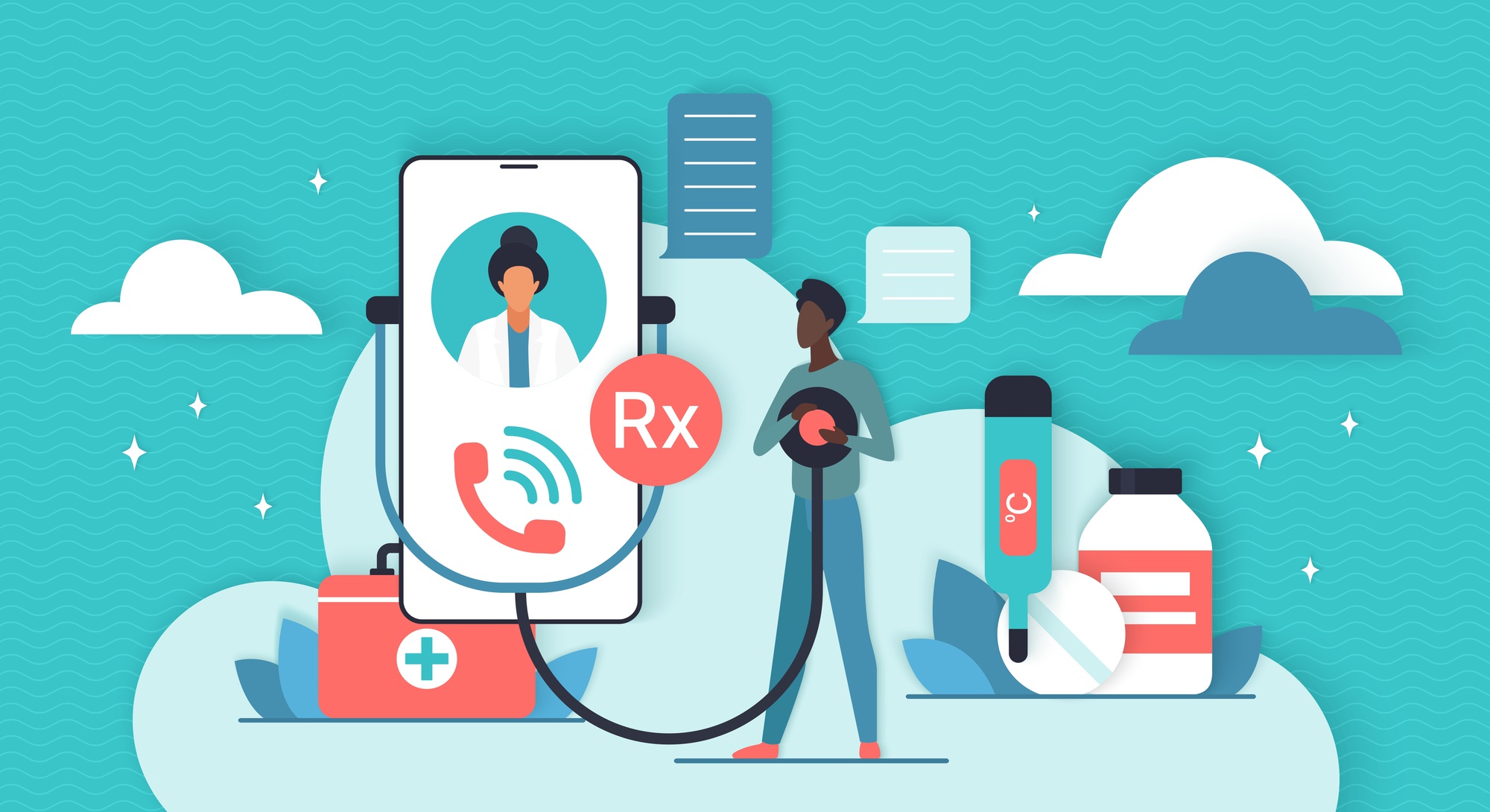In September 2021, the American Nursing Association (ANA) sent a letter to the US Department of Health and Human Services (HSS) with a request to declare the nursing shortage a national crisis. They suggested some solutions that could prevent the situation from getting worse, though they didn’t mention adopting virtual nurse assistant apps as a practical way to deal with the problem. But, as the success of Sensely shows, it should be on the list.
Sensely, a virtual nurse assistant, is an AI-powered interactive app for patients, providers, pharma, and healthcare employers that aims to optimize medical workflow, automate routine processes, decrease monitoring costs, and improve patient outcomes. Creating a Sensely-like app can help medical organizations deal with many healthcare challenges, including a nursing shortage.
This article reviews what a virtual nurse assistant is, what benefits this solution can bring, and what you should know before developing it.
What is a virtual nurse app & how does it work?

In short, a virtual nurse assistant collects data from patients just like a nurse would, except it can cover multiple patients simultaneously and automatically send data to EMR/EHR systems. Let’s look at Sensely as an example.
Sensely is a nurse avatar in the form of a smart chatbot named Molly that patients can communicate with by responding to the bot’s questions with text or voice. Powered with AI components, like natural language processing (NLP) algorithms and BeyondVerbal, Affectiva, MindMeld tools, Molly can perform speech-to-text conversion and even give insight into a patient’s emotional background at the time of assessment.
The avatar can do routine checks to receive information about patients’ current conditions and needs. The questions the app asks follow the HSS-standardized assessment protocols used by healthcare providers. After a patient completes a report with the avatar, the app sends it to the patient’s medical record, where an authorized practitioner evaluates it and suggests further action as needed.
Who can use apps like Sensely?
Sensely or similar custom virtual nurse apps are primarily intended to automate nursing routines. But the product may be a helping hand for all medical procedure participants:
-
Patients. Both inpatients and outpatients can use a virtual assistant app as either a stand-alone or as part of a treatment plan. For example, the Sensely website has a trial version of the assistant that lets patients self-assess symptoms by answering the app’s questions.
-
Providers. Burnout due to the Covid-19 pandemic is a reality for many medical providers. A virtual nurse app decreases the workload for nurses without compromising care quality.
Although Sensely is also useful for insurers and pharmaceutical industries as a tool for engagement and marketing purposes, this article focuses on the value of virtual nurse assistants for providers and patients.
So, why should you create a virtual nurse app?
Key reasons for developing a virtual nurse assistant app

Developing a virtual nurse assistant has many benefits for healthcare organizations, from reducing administrative costs to cutting time spent on daily rounds. Here’s a list of the positive effects of having such an app in practice:
-
Reducing care costs. The Sensely case study shows that the app reduced the labor cost of patient monitoring by 66%, compared to an in-person-only routine.
-
Mitigating nursing crisis. Understaffing, overworking, and exhaustion are the most commonly reported causes for the decreased performance of nurses due to Covid-19. With AI nurses in place, the nursing staff can still get needed updates on patients’ conditions while spending less time with those who don’t need in-person assessment and more time with those who do.
-
Providing care to patients with chronic diseases. As of 2021, 50% of the American population reported having at least one chronic disease (heart disease, cancer, diabetes, etc.) These conditions require ongoing medical attention, but some patients don’t get the attention they need due to a lack of medical staff. With an AI-powered app, patients with chronic conditions can book appointments, access on-demand consultations, and get emergency services in a few clicks.
-
Providing care to the elderly. By 2050, the number of people over 60 will increase from 12% to 22% of the world’s population, which will affect healthcare systems across the world. This means that more people will need medical assistance supported by agetech. Developing a virtual nurse app like Sensely is a strategic step toward providing necessary services to more people.
-
Collecting data to prepare for the future. The beauty of chatbots is that they collect and save information that can be analyzed and put to work. For instance, if many assessments identify heart disease symptoms, medical practices can hire more specialists to meet patients’ needs.
Virtual nursing apps are a future-proof investment that will prepare your practice for upcoming challenges. But what features should they have? Let’s explore.
Read also: How to set up virtual waiting room for hospitals.
Virtual nurse app features to consider

When deciding to build a virtual nurse app, it’ll, of course, include standard bot features, but its feature set will depend on the protocol requirements of the target country and the needs of the medical organization.
Sensely’s laptop trial chatbot offers the following services:
-
Symptom assessment
-
Chronic patient care
-
Insurance services
-
Health risk assessment
-
Wellness assessment
-
Mental health services
If you plan Sensely-like app development, we suggest you include the following features on the patient and nurse sides.
Features for patients
Many websites have chatbots these days, and users like them for various reasons. For example, when it comes to commerce, 68% of respondents mentioned the bot’s 24/7 availability as their #1 value and also said that they like chatbots because they provide quick answers to questions.
But Sensely isn’t a chatbot only. What features should an effective nurse assistant have to benefit patients in the healthcare sector? Here’s a list:
-
Profile creation and log in/sign up. These enable users to log in with their basic credentials (email, phone, name, etc.) and password. Additionally, you may add an “Emergency” button to direct the patient to the ER practitioners if there’s an urgent issue if there’s no time to put in credentials.
-
Avatars. Humans like to engage with humans, so adding avatars with human-like qualities to a digital bot will increase engagement and enhance the overall user experience.
-
Conversational chatbots. Powered by NLP, conversational chatbots process patients’ answers using human logic to provide relevant and accurate responses.
-
Symptom checker. The chatbot avatar should collect information about symptoms to interpret the patient’s condition. The algorithm should follow the same protocols used during in-person checks.
-
Educational content. This part of the bot contains additional information that patients may need (dietary recommendations, how-tos, reliable healthcare stats, etc.)
-
Online consultation. Consultations are one of many nursing tasks that nurses can do online using a telehealth framework. If your practice provides telehealth services, having a redirect option from the virtual nurse app to a telehealth platform would be a big plus for patients.
-
Reminders, alerts, and calendars. Reminding patients to take their medication on time is a part of a nurse’s job. The virtual nurse assistant can send digital reminders and set alarms. Also, consider adding a calendar so patients can check on upcoming appointments.
-
Appointment management. This feature enables users to book, postpone, or cancel appointments via chatbot without calling the provider’s office.
-
Maps with nearby facilities. Show users the nearest hospitals or practices. You can include a search that can be filtered by which insurance is accepted.
-
Voice recognition. For patients uncomfortable with texting replies to the assistant’s questions, you can offer a voice-response option. Older people who may not be tech-savvy will definitely appreciate this.
This is a basic feature set for patients to interact effectively with a nurse assistant. What should be on the provider side?
Features for nurses
Since a virtual nurse assistant aims to automate nurses’ work and save labor costs, the app should include the following features:
-
Profile creation and log in/sign up. For the system to authorize access and track who viewed patient reports, each nurse must create a unique profile with login credentials. This will help ensure HIPAA compliance and allow providers to identify who accessed which records.
-
Patient EMR management. A virtual nurse assistant linked to EMRs allows patient reports to be added to their medical records. Nurses will be able to review them and leave comments for doctors.
-
Reports and analytics. This feature helps nurses assess patients’ health conditions and can give medical staff the information they need to evaluate the likelihood of hospitalization, readmission, and other healthcare scenarios.
-
Symptoms guides, procedure protocols and other education content. Including reference material in a virtual nurse assistant helps nurses find information quickly and decrease the incidence of mistakes during assessments. Plus, chatbot tutorials, research reports, or other content will help nurses manage the caregiving process.
-
Push notifications. Notifying nursing staff about upcoming events, at-risk patients, and other issues that require attention keeps nurses on track.
-
Appointment management. This feature allows nurses to process appointments requests quickly.
-
Online consultation. If paired with videoconferencing technologies, the virtual nursing app can serve as a platform for patients to receive immediate online consultations.
-
Payment and claim management. If your chatbot redirects patients to billing, providers should receive identification information to complete transactions.
-
Marketing tools. Providers can use a chatbot as a marketing tool to inform patients about promotions and new services.
Now that you understand the functions of a virtual nursing assistant, what do you need to do to get one up and running?
How to create a virtual nurse assistant like Sensely

For virtual nurse assistant development, we apply the same steps as during any other app creation, from strategy to deployment and testing. However, healthcare development has a lot of specific requirements that other projects might not.
First of all, the developer team should work closely with the organization’s in-house technicians to ensure compatibility between the existing hardware and software the organization has and what’s being developed. Second, you need to involve real nurses in the process to provide insight regarding functions, protocol procedures, and necessary databases. Finally, you should make sure that all third-party software you plan to use is compatible with the legal requirements of the target country.
Now, let’s review each mobile app development stage in detail.
Step 1: Strategy
Creating a working strategy for a nursing app means aligning performance and business needs with the technical possibilities and plan. At this stage, you identify the key users, how the app will integrate with your IT ecosystem, the desired functionality, and outcomes based on target user surveys (i.e., nurses, patients, doctors, facility managers).
Step 2: Requirement analysis
At this stage, developers you’ve hired study the industry's requirements for medical data processing, legacy system requirements and compatibility, user needs, etc. The team then performs project cost and timeline estimation based on factors like technology, workforce, resources, and so on.
Step 3: Planning
The planning stage is always important, especially for custom virtual nurse apps being integrated with other systems already in use. The team needs to spell out development details for each feature and inform the medical organization about the potential downtime of existing systems. At this point, the team should also identify any data that might need to migrate.
Step 4: Prototyping and design
Now the development team comes up with the app layout, interlinking, and user flow. The prototyping stage needs to be reviewed by users who can give feedback on whether the logic of functions aligns with the logic of protocols.
Step 5: Development
Here, developers begin coding, and, eventually, all the individual pieces of code are gathered into one system. After development is done, the team checks it for acceptance, meaning whether the app they built performs its intended functions.
Step 6: Testing
As the app passes the development and acceptance stages, it’s time to test performance, reliability, and response functionality. Here, users test to see if the design provides a positive user experience. All post-development issues are resolved at this stage before deploying the app.
Step 7: Deployment and maintenance
After app testing, it’s time to deploy and integrate the app and test for connectivity issues. At this stage, the development team connects the app with the legacy system, creates emergency backup protocols, and then maintains the app after deployment.
Each of these stages is necessary if you want to avoid unpleasant surprises, like ending up with an app that violates data processing laws. Below, we list the top challenges of the development process.
Challenges associated with virtual nurse app adoption

As much as we’d like the development process to be easy and smooth, some issues may require more development time or resources before a successful launch. Here’s a list of challenges you may face during virtual nurse app development.
-
Legacy system integration. Deploying the app and connecting it with an existing system is a challenge for all developers. Sometimes, the legacy systems need additional components to ensure smooth performance, which can extend deadlines and affect the final cost of a project.
-
Legal compliance. Before choosing the technologies to include in an app, the developer team should know the local legal requirements for medical apps. Development agencies with no expertise in healthcare app development will need more time, compared to agencies with healthcare expertise, to build solutions that don’t violate privacy policies and data processing requirements.
-
Staff education. To make a virtual nurse app is one thing, but to teach personnel to use it correctly is another. Developers and the medical staff will need to create tutorials, workshops, and performance assessments so that users know the functions of the app in and out.
After you’ve launched the nurse app and gotten positive feedback from users on both ends (providers and patients), it’s time to monitor changes in the medical environment. Laws constantly change, technologies evolve, and patient needs grow. This means you need to know when to update your app so users (and your company) can continue benefiting from it. And a reliable tech partner can help you with this.
Dive into virtual nurse app development with Demigos!
Medical technology can lend a helping hand with staffing shortages, exhaustion, and the upcoming burden associated with an aging society that nurse organizations frequently discuss. The success of virtual nurse assistant apps like Sensely, with their NLP-powered algorithms, can decrease patient monitoring costs, provide access to medical services to at-risk groups at all times, and transform the way nurses deliver patient care.
If you’re considering investing in virtual nurse app development, the Demigos team is here for you. Our company is an expert in custom agetech and healthtech app creation, and we’re ready to put our knowledge to work for your business so you can deliver better, more accessible, and more efficient care. Contact us to talk about your project!






